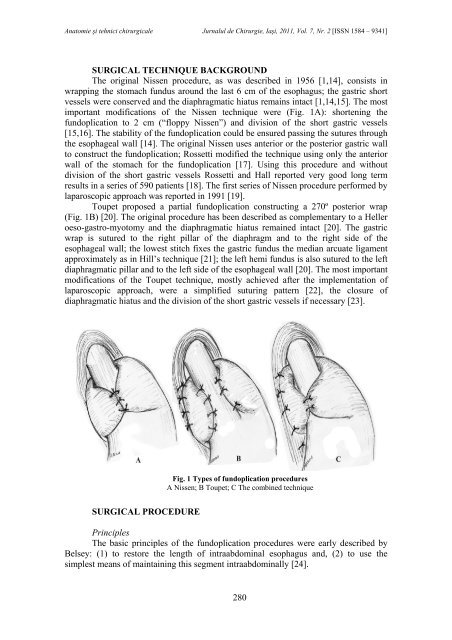PDF (4 MB) - Jurnalul de Chirurgie
PDF (4 MB) - Jurnalul de Chirurgie
PDF (4 MB) - Jurnalul de Chirurgie
- No tags were found...
Create successful ePaper yourself
Turn your PDF publications into a flip-book with our unique Google optimized e-Paper software.
Anatomie şi tehnici chirurgicale <strong>Jurnalul</strong> <strong>de</strong> <strong>Chirurgie</strong>, Iaşi, 2011, Vol. 7, Nr. 2 [ISSN 1584 – 9341]<br />
SURGICAL TECHNIQUE BACKGROUND<br />
The original Nissen procedure, as was <strong>de</strong>scribed in 1956 [1,14], consists in<br />
wrapping the stomach fundus around the last 6 cm of the esophagus; the gastric short<br />
vessels were conserved and the diaphragmatic hiatus remains intact [1,14,15]. The most<br />
important modifications of the Nissen technique were (Fig. 1A): shortening the<br />
fundoplication to 2 cm (“floppy Nissen”) and division of the short gastric vessels<br />
[15,16]. The stability of the fundoplication could be ensured passing the sutures through<br />
the esophageal wall [14]. The original Nissen uses anterior or the posterior gastric wall<br />
to construct the fundoplication; Rossetti modified the technique using only the anterior<br />
wall of the stomach for the fundoplication [17]. Using this procedure and without<br />
division of the short gastric vessels Rossetti and Hall reported very good long term<br />
results in a series of 590 patients [18]. The first series of Nissen procedure performed by<br />
laparoscopic approach was reported in 1991 [19].<br />
Toupet proposed a partial fundoplication constructing a 270º posterior wrap<br />
(Fig. 1B) [20]. The original procedure has been <strong>de</strong>scribed as complementary to a Heller<br />
oeso-gastro-myotomy and the diaphragmatic hiatus remained intact [20]. The gastric<br />
wrap is sutured to the right pillar of the diaphragm and to the right si<strong>de</strong> of the<br />
esophageal wall; the lowest stitch fixes the gastric fundus the median arcuate ligament<br />
approximately as in Hill’s technique [21]; the left hemi fundus is also sutured to the left<br />
diaphragmatic pillar and to the left si<strong>de</strong> of the esophageal wall [20]. The most important<br />
modifications of the Toupet technique, mostly achieved after the implementation of<br />
laparoscopic approach, were a simplified suturing pattern [22], the closure of<br />
diaphragmatic hiatus and the division of the short gastric vessels if necessary [23].<br />
Fig. 1 Types of fundoplication procedures<br />
A Nissen; B Toupet; C The combined technique<br />
SURGICAL PROCEDURE<br />
Principles<br />
The basic principles of the fundoplication procedures were early <strong>de</strong>scribed by<br />
Belsey: (1) to restore the length of intraabdominal esophagus and, (2) to use the<br />
simplest means of maintaining this segment intraabdominally [24].<br />
280
















